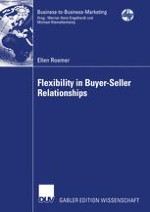Foreword Long-term buyer-seller relationships are a real and important phenomenon in business-to business markets. Since the consequences for the parties to a relationship heavily depend on the management of these relationships, research becomes increasingly intensive to explain the real phenomenon of buyer-seller relationships. On the one hand, the objective is to determine when relationships are a reasonable form of coordination in markets. On the other hand, the management of the relationship itself is in the focus of the analysis. Transaction Cost Economics (TCE) has been proven a fruitful theoretical approach explaining both research objectives. TCE provides not only insights in which situations relationships are economically reasonable but also which activities are appropriate to protect ex post benefits on both sides of the relationship from an ex ante perspective. In relation to the second research objective of the buyer-seller relationship manage ment, safeguarding mechanisms - protection against opportunistic behavior - were in the center of the analysis in the business-to-business relationship literature. In contrast, the flexibility to react to changing environmental conditions was largely neglected in buyer seller relationship management. The reason for this one-eyed perspective can be traced back to the comparative static approach as proposed by TCE comparing the efficiency of different coordination forms at one point of time. Intuitively it becomes clear that con tractual safeguards to limit behavioral uncertainty do not only provide advantages but also reduce the repertoire of the parties to react to future, unexpected developments.
